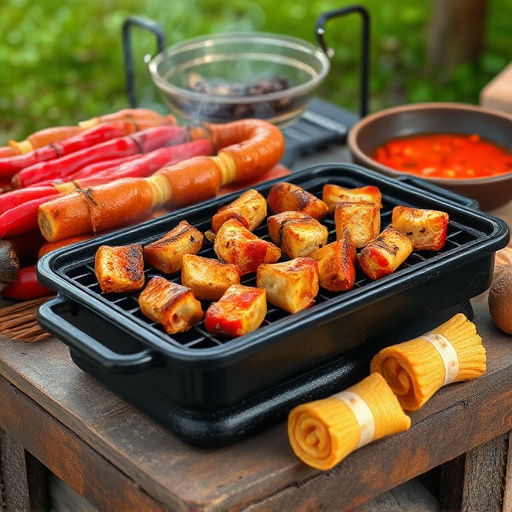Selecting the perfect cut of beef ribs with good marbling and bone-in rib eye or short rib ensures maximum flavor and tenderness. Slow cooking at 250°F (120°C) for several hours breaks down collagen, resulting in tender, juicy ribs. Using a meat thermometer to reach an internal temperature of 203°F (95°C) guarantees optimal results. Resting the ribs post-cooking and cutting against the grain enhances juiciness. Accompany with classic sides like coleslaw, corn on the cob, baked beans, potato wedges, garlic bread, a green salad, and homemade vinaigrette for a complete BBQ beef ribs experience.
“Indulge in the mouth-watering aroma of perfectly cooked, tender juicy beef ribs—the epitome of a satisfying BBQ meal. This comprehensive guide takes you on a journey from choosing the best quality ribs to mastering the art of slow cooking and seasoning. Learn the secrets behind creating succulent ribs that fall off the bone. With tips on dry rub recipes, cooking techniques (smoking vs. baking), temperature control, resting, slicing, and side dishes, this article is your ultimate resource for crafting the perfect BBQ beef ribs recipe.”
- Choosing the Right Ribs: Tips for Quality Beef Ribs
- Dry Rub Seasoning: A Blend to Make Your Ribs Pop
- Slow Cooking Technique: The Art of Patience in Cooking
- Smoking or Baking: Which Method is Best for Tender Ribs?
- Measuring Temperature: Ensuring Ribs Are Cooked to Perfection
- Resting and Slicing: How to Maintain Moisture and Juiciness
- Accompanying Sides: Completing Your BBQ Beef Ribs Meal
Choosing the Right Ribs: Tips for Quality Beef Ribs
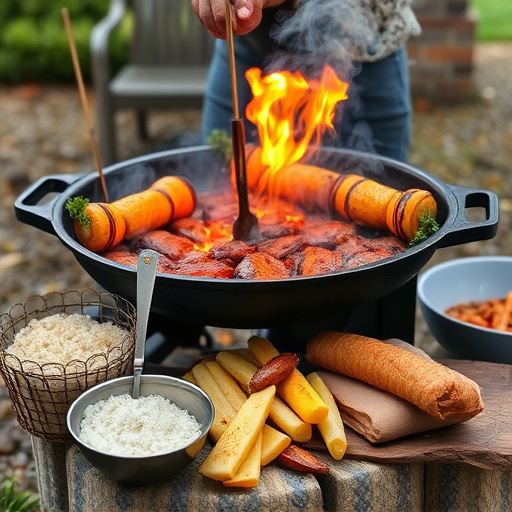
When it comes to crafting the perfect BBQ beef ribs recipe, selecting the right cut is half the battle won. Look for ribs with good marbling—the fat streaked throughout the meat—as this adds flavor and tenderness. The meatiest and most flavorful options are typically rib eye or short rib cuts, ensuring a juicy result after slow cooking. Opting for bone-in ribs isn’t just about tradition; the bones themselves contribute to the meat’s juiciness by holding in moisture during the long, slow cook.
Consider the thickness of your ribs too. Thicker cuts take longer to cook and may require more attention to prevent overcooking or drying out. For a reliable outcome, choose ribs that are at least 1.5 inches (3.8 cm) thick. Properly stored, high-quality beef ribs can keep for several days in the refrigerator or freezer, allowing you to plan ahead for your next mouthwatering BBQ session.
Dry Rub Seasoning: A Blend to Make Your Ribs Pop
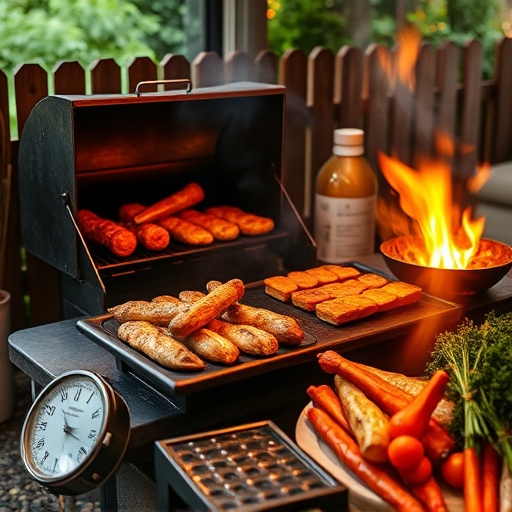
Dry Rub Seasoning is a crucial component in achieving tender, juicy BBQ beef ribs that’ll have your taste buds doing a dance. This blend of spices isn’t just a coating; it penetrates deep into the meat during the slow-cooking process, infusing each rib with a burst of flavor. The secret lies in balancing sweet, savory, and heat—a symphony of sensations that distinguishes your ribs from the rest.
Crafting your own Dry Rub allows for customization based on personal preference. Common ingredients include brown sugar for sweetness, paprika for smokiness, garlic and onion powder for pungency, salt and pepper for a salty kick, and cayenne or chili powder for heat. This versatile seasoning isn’t exclusive to ribs; it can elevate various dishes, from roasted chicken to grilled steak, making it a staple in any kitchen.
Slow Cooking Technique: The Art of Patience in Cooking
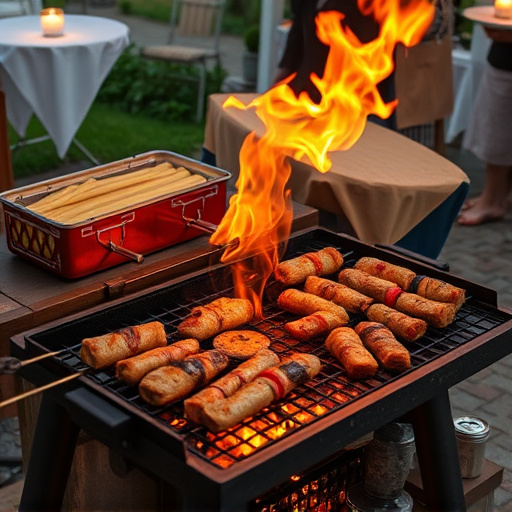
Slow cooking is an art that requires patience and precision, especially when crafting a mouthwatering BBQ beef ribs recipe. This technique allows the meat to break down slowly, making it incredibly tender and juicy. By using low heat over an extended period, the collagen in the ribs reloads, resulting in a melt-in-your-mouth texture. It’s a process that defies haste; instead, it embraces time as an ally in the kitchen.
The beauty of this method lies in its ability to transform tougher cuts of meat into delectable dishes. In the case of BBQ beef ribs, slow cooking ensures every bite is packed with flavor, whether you’re using a crockpot or a traditional oven. This technique is not just about cooking; it’s an experience, allowing you to create culinary masterpieces that tell a tale of patience and perfection.
Smoking or Baking: Which Method is Best for Tender Ribs?
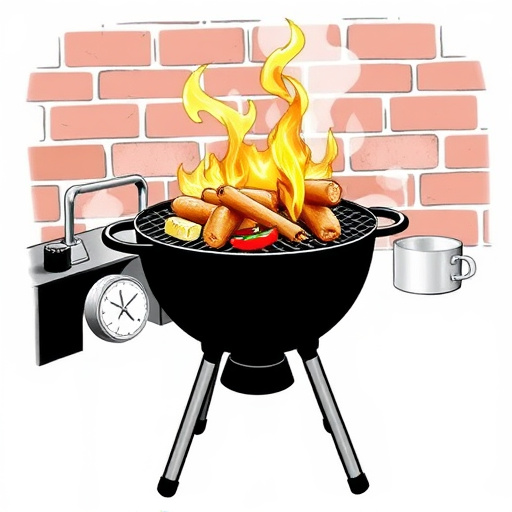
When it comes to achieving tender, juicy BBQ beef ribs, the age-old debate arises: smoking or baking? Both methods have their ardent proponents, but for a truly optimal result, slow cooking using low and moist heat is key. Smoking offers a distinctive smoky flavor that many love, but high temperatures can make ribs tough if not carefully managed. On the other hand, baking ensures even cooking without adding smoke flavor, making it ideal for those who prefer a milder taste or don’t have access to a smoker.
For a successful BBQ beef ribs recipe, consider starting with a dry rub to enhance flavors before slow-roasting them at low temperatures—around 250°F (120°C)—for several hours until the meat is incredibly tender. This method ensures juicy, fall-off-the-bone ribs that satisfy even the pickiest of eaters.
Measuring Temperature: Ensuring Ribs Are Cooked to Perfection
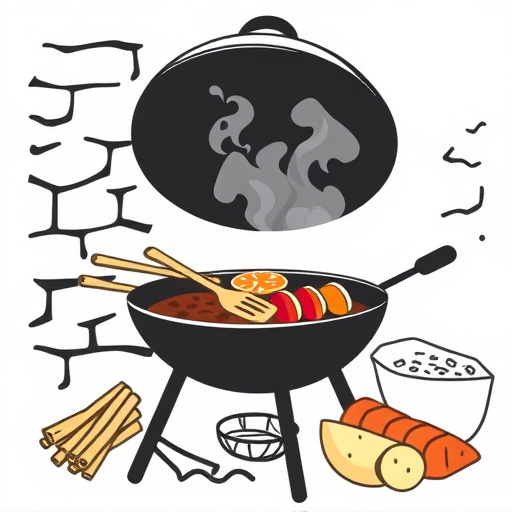
Measuring temperature is a critical step in achieving perfectly cooked BBQ beef ribs, as it ensures those tender, juicy results you’re aiming for. The ideal internal temperature for slow-cooked beef ribs hovers around 203°F (95°C). This might seem counterintuitive, as you’d expect ribs to be sizzling hot, but overcooking leads to dryness and tough meat. Using a reliable meat thermometer inserted into the thickest part of the rib, you can accurately monitor the cooking process.
This precise temperature control allows you to rest the ribs once they reach the desired level, locking in that mouthwatering moisture. Remember, slow and steady wins the race when it comes to BBQ beef ribs recipes – let the ribs cook gently until they reach that perfect 203°F, and your efforts will be rewarded with a delectable, fall-off-the-bone feast.
Resting and Slicing: How to Maintain Moisture and Juiciness
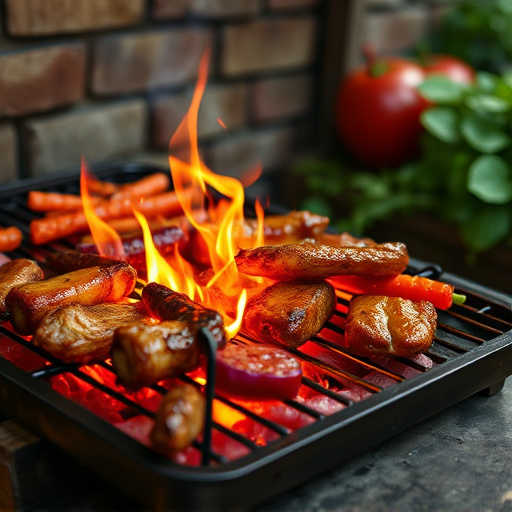
After slow cooking your BBQ beef ribs to perfection, the next crucial step is resting and slicing. During this rest period, the juices redistribute throughout the meat, ensuring each bite remains tender and juicy. Cover the ribs loosely with foil or a clean kitchen towel, and let them sit for at least 15-20 minutes before slicing. This simple step helps to maintain the delicious moisture and juiciness that makes BBQ beef ribs such a treat.
When it’s time to slice, use a sharp knife to cut against the grain of the meat. This technique ensures each slice is both tender and easy to chew. Avoid cutting with the grain, as this can result in dry, tough ribbons of meat. Proper slicing not only enhances the dining experience but also ensures every mouthful lives up to the expectations set by your slow-cooked BBQ beef ribs recipe.
Accompanying Sides: Completing Your BBQ Beef Ribs Meal

When it comes to serving up perfect BBQ beef ribs, the right sides can elevate your meal from good to great. Consider classic barbecue favorites like coleslaw—a tangy blend of cabbage and carrots that cuts through the rich, tender meat. Corn on the cob, grilled or boiled, adds a touch of sweetness and summer vibes. Baked beans, another staple at any BBQ, offer a hearty, sweet, and savory side dish that complements the ribs nicely.
For an extra indulgent experience, incorporate crispy potato wedges or garlic bread to soak up the mouthwatering rib juices. Don’t forget about fresh salads—a crisp green salad with a homemade vinaigrette provides a refreshing contrast to the rich ribs. These side dishes not only round out your bbq beef ribs recipe but also cater to various tastes, ensuring everyone at the table enjoys their meal to the fullest.
